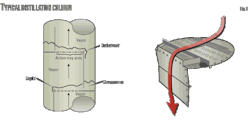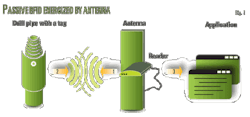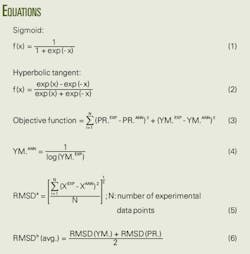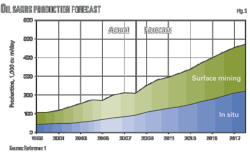A large number of simulation tests helped determine the causes of casing wear problems in Tarim oil field.
The tests determined casing wear mechanisms and the effect of wear parameters such as lateral forces, rubber protectors, antifriction agents, and drill pipe wear-resistant belts.
The tests used the Maurer physical wear testing machine and related software and determined that antifriction agents could reduce and control casing wear in deep wells in Tarim oil field.
Tarim casing wear
Tarim oil field, in western China, had experienced casing wear problems in several wells since 1989. Wells with problems included Keshen-1 and well Yangxia-1 in 1996; Yaken-3 in 1997; Kela-202 in 2000; and Quele-1, Dina-1, Qiu-1, Kesheng-101, and Dina-11 in 2000.
The casing wear in these wells caused an economic loss from unnecessary monitoring, well logging, and remediation.
Tarim oil field, therefore, launched a research project on casing wear with the Xian Maurer Petroleum Engineering Laboratory and China University of Petroleum. The research used the latest CWEAR (casing wear prediction) software in cooperation with Maurer Technology Inc.
The field lacked wear factor and friction coefficients for the drill pipe, casing, and drilling fluid model; therefore, it was necessary to use the physical wear testing machine in the Xian Maurer Petroleum Engineering Laboratory for determining casing wear data for building a casing wear database for Tarim oil field.
The project studied casing wear under the current drilling conditions in Tarim oil field and determined factors and friction coefficients for different combinations of casing, drill pipe, and drilling fluids.
The software can provide technical guidance for drilling and production in real-time analysis of casing wear depth and casing strength and also for evaluating wear resistance technology programs for preventive and remedial measures.
Tests
The experiments included:
• Simulation tests of casing-wear mechanisms.
• Tests for the effect of drill pipe load on casing wear under high, middle, and low lateral loads.
• Tests for the effects of drill pipe rubber protectors on casing wear in a weighted mud system containing iron ore fines, in a mud system contained compounds of iron ore fines and barite, as well as the damage to the rubber protector from casing surface quality (original state and polished surface), and the protector (straight and spiral) wear on the casing.
• Tests for the effects of mud weighting agents on casing wear such as the effect of different ratios of iron ore fines and barite and different antifriction agents.
• Tests for the effects of tool joints welded with wear-resistant belts on casing wear included the effect of steel tools, tungsten carbide (WC) wear-resistant belts, five new types of wear-resistant alloys, surface quality of wear-resistant belts, and life of wear-resistant belts under openhole conditions.
Simulation tests
The four types of wear mechanisms involved in casing wear include machining, galling, grinding, and polishing wear. To investigate the occurrence of different wear mechanisms and wear characteristics, we chose test conditions and used a scanning electron microscope (SEM) to analyze the casing wear surface and wear debris.
We selected four types of test conditions (Table 1) based on lateral force, friction material hardness, and characteristics of friction pairs.
| These photos show machining wear micromorphology of the casing surface (on left at x500 SEM) and wear debris (center at x20 SEM, right at x200 SEM). The surface of the worn casing had obvious machining traces, and the wear debris formed chips (Fig. 1). |
In Test 1, the casing wear mechanism was mainly from machining. Fig. 1 shows the micromorphology of the casing surface and wear debris. The casing wear mechanism is prone to machining under a high lateral force, surface of tool joints welded with tungsten carbide, and a nonabrading agent between the tool joints and casing surface.
The surface of the worn casing had obvious machining traces and the wear debris formed chips.
| These photos show galling micromorphology of the casing surface (on left at x500 SEM) and wear debris (center at x20 SEM, right at x200 SEM). The surface of the worn casing had an obvious galling area and plastic deformation. The wear debris formed flakes, and the surface of the wear debris had shear wave and shear tear characteristics (Fig. 2). |
In Test 2, the casing wear mechanism was principally galling. Fig. 2 shows the micromorphology of the casing surface and the wear debris. The casing wear mechanism was prone to galling under a high lateral force, similar surface hardness of tool joints and casing, and a nonabrading agent between the tool joints and casing.
The surface of the worn casing had an obvious galling area and plastic deformation. The wear debris formed flakes, and the surface of the wear debris had shear wave and shear tear characteristics.
| These photos show grinding micromorphology of the casing surface (on left) and wear debris (center and right). The surface of the worn casing had an obvious galling area and plastic deformation. The surface of the worn casing showed traces of being pressed and cut by hard particles and rigid particles. The wear debris formed a powder (Fig. 3). |
In Test 3, the casing wear mechanism was chiefly grinding. Fig. 3 shows the micromorphology of the casing surface and wear debris. The casing wear mechanism was prone to grinding under high lateral force and the abrading agent between the tool joints and casing surface.
The surface of the worn casing had traces of being pressed and cut by hard particles and rigid particles. The wear debris formed a powder.
In Test 4, the casing wear mechanism was mainly polishing wear. Fig. 4 shows the polishing wear microstructure. The soft surface of a rubber protector had a role in polishing the casing surface. The casing did not wear, and the wear debris rarely formed when polishing wear occurred.
The wear factors for machining, galling, grinding, and polishing were 230 × 10–10/psi, 48.3 × 10–10/psi, 7.67 × 10–10/psi, 0.1 × 10–10/psi, respectively.
The wear factor measured in the wear mechanism test was consistent with the wear factor range in Maurer's classification of wear mechanisms.1 Table 2 describes the wear debris morphology and wear debris for Maurer's classification of wear mechanisms.
From these test results, we determined that the field should try to avoid machining wear and galling, and change these two types of serious wear types into grinding wear and polishing wear during the drilling process.
Lateral load effect
The conditions for testing the effect of lateral loads on casing wear were:
• 1,000 lb/ft, 3,000 lb/ft, 5,000 lb/ft lateral force.
• 95⁄8-in. casing.
• TP-110 and TP-140 steel grade.
• Drilling fluid composition provided by Tarim oil field.
• Tool joints welded with XT100 wear-resistant belts.
• 8-hr test time.
• 158 rpm tool joint rotary speed.
Fig. 5 shows the effect of the lateral force on casing wear. The tests under different lateral forces found that the measured parameters of casing wear rate, wear factor, and friction coefficient varied greatly.
The casing wear rate, wear factor, and friction coefficient increased nonlinearly with an increased lateral force. Grinding was the wear mechanism under different lateral forces according to the wear factor.
With the lateral force increasing, a microbulge produced distortion, the contact area increased, and the friction coefficient increased.
The casing wear was different for different steel grades. The wear resistance of TP140 was better than that of TP110 in the tests.
The lateral force was an important factor on casing wear; therefore, drillers should strictly control dogleg severity to reduce the lateral force between the drill pipe and casing, particularly at shallower depths.
Drill pipe rubber protectors
The conditions for testing the effect of drill pipe rubber protector on casing wear were:
• 3,000 lb/ft lateral force.
• 95⁄8-in. casing.
• TP-110 and TP-140 steel grade.
• KCl polysulfonate less saturated brine system mud, containing iron ore fines as used Tarim oil field.
• Tool joints with straight and spiral (helical type) rubber protectors.
• 8-hr test time.
• 158 rpm tool joint rotary speed.
Fig. 6 shows the effect of the drill pipe rubber protector on casing wear and Fig. 7 compares the wear for different casing surfaces.
Casing wear rate was generally 1-3% in the 8-hr test with a rubber protector, while casing wear rate was generally more than 10% in the 8-hr test with tool joints welded with a wear-resistant belt.
The effect of a rubber protector on wear resistance was obvious, and the impact of wear resistance was about 80%.
The wear on the rubber protector was relatively large, but it did not affect its wear-resistance effects in mud containing a large number of iron ore fines.
The damage on the rubber protector was related to casing surface state, especially rough surfaces and high hardness surfaces. With grinding, polishing, and not grinding, the radial wear depth of rubber protector was 0.457 mm, 0.381 mm, and 1.118 mm, respectively.
The wear testing machine system with straight rubber protectors vibrates more than with the slanted rubber protectors. The straight rubber protectors also had more casing wear.
Mud weighting agents
The conditions for testing the effect of different mud weighting agents were:
• 3,000 lb/ft lateral force.
• 95⁄8-in. casing.
• TP-110 and TP-140 steel grade.
• 8-hr test time.
• 158 rpm tool joint rotary speed.
Table 3 lists other wear test conditions.
Fig. 8 shows the effect of mud weighting agent on casing wear, and Fig. 9 shows the effect of casing wear rate, wear factor, and friction coefficient with different antifriction agents.
The wear resistance effect of barite was obvious. Barite and iron ore fines in an appropriate ratio also could minimize casing wear. The tests showed that casing wear was relatively small when the proportion of barite and iron ore fines was 2:1 and 1:1.
The wear rate and wear factor increased with increased iron ore fines in the mud, but the effect of iron ore fines on casing wear was not much under test conditions. Grinding was still the wear mechanism.
The effect of antifriction agents on casing wear played a distinct role in the nonweighted mud, especially clean water.
The casing wear rate was as high as 40.04% and 50.42% under wear test conditions of Series 1 (clean water, joint welded XT100) and Series 3 (clean water, steel tool joints). The wear mechanisms were grinding wear and galling wear, respectively.
After including an antifriction agent (Series 2 and Series 4), the wear mechanism was transformed into polishing wear, and the friction coefficient decreased to 0.055 and 0.066. The casing wear rate decreased more than 90%.
In the nonweighted mud (Series 5 and Series 6), the antifriction agent reduced the casing wear rate by 27% or more.
Casing wear rate, wear factor, and friction coefficient were reduced in KCl polysulfonate less saturated brine system mud with antifriction agents A and B.
Tool-joint hard banding
The conditions for testing the effect of tool-joint hard banding on casing wear were:
• 3,000 lb/ft lateral force.
• 95⁄8-in. casing.
• TP-110 and TP-140 steel grade.
• KCl polysulfonate less saturated brine system mud, (2:1 ratio of iron ores to barite fines) used in Tarim oil field.
• Tool joints welded with different wear belts of 4145 steel, WC, XT100, and NT2000.
• 8-hr test time.
• 158 rpm tool joint rotary speed.
Fig. 10 shows the effect of wear-resistant of tool joints welded with 4145 steel, WC, XT100, NT2000 on casing wear, and Fig. 11 shows the effect of several new types of wear-resistant alloys on casing wear.
Fig. 12 shows the wear depth on tool joints welded with several antifriction alloys.
The wear of steel tool joints on casing was severe. A lot of heat crack and metal peeling occurred on the surface of steel tool joints because the instantaneous temperature was too high during the wear process.
The wear mechanism of casing tested with tool joint welded with WC was mainly machining wear. The casing wear was serious, but the joint wear was minor.
The effect of several new types of antifriction alloys made in China on casing wear was similar to that made abroad. Wear of BoTn1000 and nano steel was less among several new antifriction belts. Casing wear was also less for BoTn1000. The casing wear was very low for NT2000, but the depth worn by wear-resistant belts is greater, reaching 0.427 mm after an 8-hr test.
The effect of time on new wear-resistant belts on casing wear was small. The wear on tool joints gradually slowed because its surface gradually became smooth with extended test time.
The surface of new wear-resistant belts did not have much influence on casing wear, and the casing wear depth, friction coefficient, and wear factor was less. Casing wear, however, was severe when rough tungsten carbide belts were used.
Wear is less with wear-resistant belts with smoother surfaces. Wear-resistant belt surfaces, therefore, should be polished.
Reference
1. Improved Casing and Riser Wear Technology, DEA-42-Phase V, Maurer Engineering Inc., April 1998.
The authors
Han Yong is the director of Xian Maurer Petroleum Engineering Laboratory. He is a professor and specialist on oil country tubular goods. Han Yong holds a BS in material engineering from Xian Jiao Tong University and a PhD degree in drilling engineering from Southwest Petroleum Institute.
Ji Bingyin is an engineer at the Xian Maurer Petroleum Engineering Laboratory. He holds a BS in process equipment and control engineering from Shaanxi University of Science & Technology and an MS in engineering mechanics from China University of Petroleum.
Ouyang Chun is an engineer at the Xian Maurer Petroleum Engineering Laboratory. He graduated from Northwestern PolyTechnical University.
Xiao Guozhang is an engineer for Baoji Petroleum Steel Pipe Co. Ltd. He holds a BS and an MS in material processing engineering from Xian Shiyou University.
Tang Jiping is a professor and specialist on drilling engineering with Tarim Oilfield Co. He holds a BS in drilling engineering from Southwest Petroleum Institute.
Zhang Bin is a senior engineer at Tarim Oilfield Co. He holds a BS in drilling engineering from Jianghan Petroleum Institute and a PhD in drilling engineering from China University of Geosciences.
Liang Hongjun is a senior engineer at Tarim Oilfield Co. He holds a BS in drilling engineering from Southwest Petroleum Institute.
More Oil & Gas Journal Current Issue Articles
More Oil & Gas Journal Archives Issue Articles
View Oil and Gas Articles on PennEnergy.com















